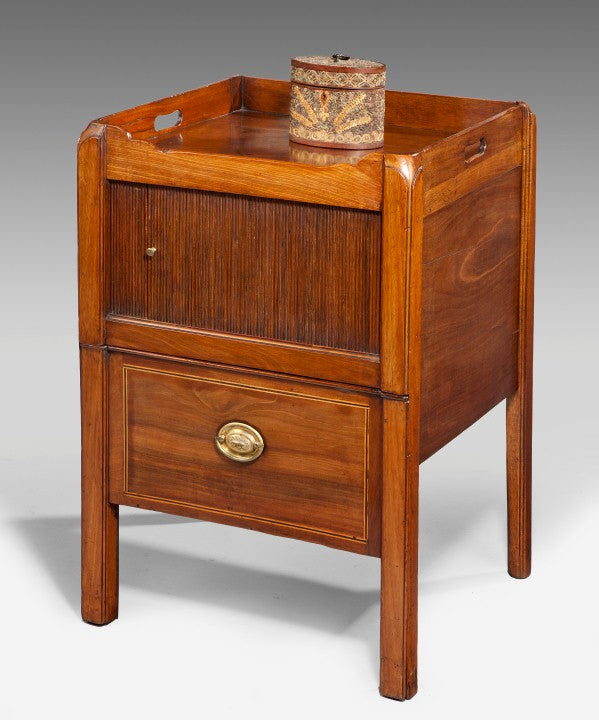Commonly Found Woods in Antique English Furniture
The wood chosen for a piece of English furniture can reveal much about where the piece was made, its date, and how expensive it might have been. We have compiled a list of the most commonly found woods in antique English furniture from the seventeenth, eighteenth and nineteenth centuries to help you identify various woods when purchasing your antiques.
Oak- In English furniture history, the Medieval era until c.1660 is commonly known as the 'age of oak'. Oak furniture can be identified by its attractive grain and typically dates from this earlier period. An oak trunk is quartered and cut along the lines of the medullary rays in the wood which produces an open-grained silvery pattern that is always much lighter than the base colour. In later pieces oak was used for drawer linings on the best quality furniture. Here we have an early oak coffer dating from c.1670 with a frieze carved of arcading on the front and fielded panels on the lid and sides.

Walnut- A softwood,walnut allowed for greater flexibility and more elaborate carving when it was introduced into furniture-making from c.1660 onwards; it became the wood of choice in both the William and Mary era (1689-1702) and during the reign of Queen Anne (1702-14). Walnut was often used as a veneer whereby thin sheets of wood would be glued to the carcase surface in order to show off its striking figure. This can be seen here in the featherbanded inlay on this fine Queen Anne period walnut veneereed bureau.

Mahogany- From the 1720s Mahogany became one of the most fashionable woods in furntiure-making. In 1721 the Naval Stores Act in England was passed which resulted in the removal of taxation on the import duty of mahogany, although as it was still expensive to import mahogany it was only used on the finest pieces. Imported from Jamacia, Cuba and Honduras, at its peak in 1788 more than 30,000 tons of mahogany were imported into England and Wales. The earliest to be imported was 'spanish mahogany' which was known for its striaght-grain and lack of figure; it was mostly used in carving. From 1750 the Cuban variety rose in popularity as it was highly figured and good for veneers. 'Baywood' which is another variation of mahogany from Honduras became fashionable and known for its light colour and weight and its used as drawer linings in better quality furniture. A strong, dense wood, mahogany varies in colour depending on its region but tends to range from medium brown to deep red-brown in colour with black specks of open grain. This Georgian period mahogany canterbury (a holder for sheet music) reinforces that mahogany was reserved for high quality pieces as not many houses could afford to keep musical instruments let alone their sheet music.

Satinwood- Satinwood is easy to identify as it shimmers like satin especially when highly polished. Imported from the West Indies from 1760 and from the East Indies from 1780 both types are yellow and honey-coloured although the former gives off a stronger shine due to its clear close-grains. Satinwood is particularly associated with the Thomas Sheraton period as can be seen in this elegant demi-lune satinwood veneered console table.

Rosewood- Rosewood rose in popularity during the Regency period. Imported from India and Brazil it is often used for veneers as it has strong contrasts of light and dark. Look for dark streaks that are almost inky blotches when trying to identify rosewood, such as can be seen on this fine Regency rosewood centre table.

Kingwood & Tulipwood- Imported from Brazil, kingwood receives its name from the royal purple hue of its grain and was often used for veneers and in cross-banded borders in the late eighteenth century. Also from Brazil, tulipwood is used in veneers and was very fashionable during the Regency period. Here we have a handsome George III Sheraton period kingwood veneered sofa table with tulipwood crossbanding on the top above the two frieze drawers.

Pine- Also known as 'deal', pine is a light yellowy wood which is often used as a cheaper subsitute to oak in drawer linings such as this George I mahogany tall-boy with pine drawer lining.

Beech- Beech is a pale brown-white wood which is commonly painted, varnished or strained to resemble another wood as a cheaper alternative. In particular beech tends to be used to resemble Rosewood such as the turned spiral twist stand on this Rosewood tripod table; this effect is known as 'faux rosewood'.

Yew & Elm- Yew is a reddish-brown wood with a wavy figure and very noticeable balck spots throughout and elm is a tough hardwood which tends to be shaped and used for seat boards. Both woods are very typical of the vernacular tradition of furniture-making such as can be seen in the archetypally English Windsor Chair with its seat made of elm and the frame and spindles made of yew.

Boxwood- A whitish-yellow wood with no real figure, often used as inlay on satinwood, rosewood and mahogany, as can be see on this tray top commode.

Ebony- A black, hard wood which was imported from the East and often used for inlays and veneers as a decorative motif such as the ebony star symbol on this pair of Regency rosewood card tables.

Footnotes
Adam Bowett, 'The 1721 Naval Stores Act and the Commercial Introduction of Mahogany', Furniture History, XXX (1994), pp.42-56.

